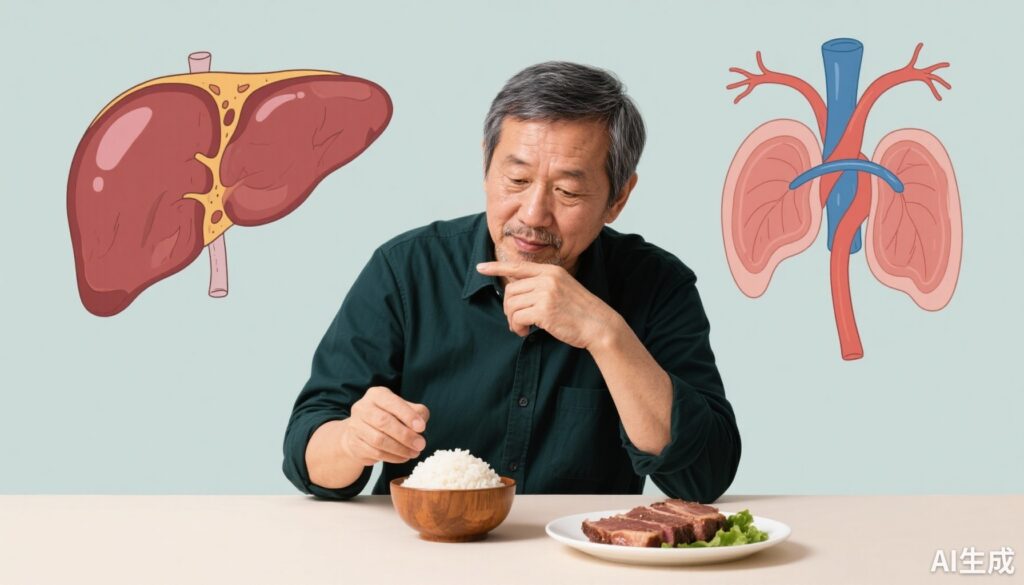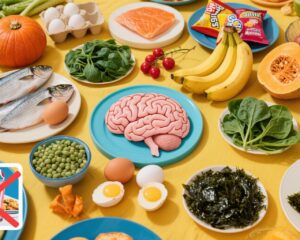Introduction
Fatty liver disease, including non-alcoholic fatty liver disease (NAFLD), is increasingly common worldwide, affecting people even in their early forties or younger. Characterized by excessive fat accumulation in liver cells, this condition can progress to inflammation, fibrosis, and serious liver damage if left unmanaged. As awareness grows, so does confusion about the best dietary approach to control and potentially reverse fatty liver, with a common debate being: “Should I eat less starch (mainly carbohydrates) or less meat (protein and fat)?” There’s a prevailing belief that carbohydrates contribute mainly to fat buildup in the liver by converting to triglycerides, while meat supposedly does not. This article examines scientific evidence to clarify these myths and offers practical advice.
Scientific Evidence: The Effects of Carbohydrates and Meat on Fatty Liver
Carbohydrate Intake and Lipid Levels
Generally, increased carbohydrate consumption can elevate blood triglycerides, a type of fat, which relates to fat accumulation in the liver. However, this rise is often reversible with adequate physical activity. For example, labor-intensive workers like porters, rickshaw pullers, or construction workers, who consume high-carb diets but have substantial daily activity, rarely develop fatty liver or high blood lipids, often maintaining lean and muscular physiques.
Fat and Protein Intake Impacts
Contrary to some beliefs, consuming large amounts of meat, which often contains fat, increases circulating free fatty acids, promoting insulin resistance and higher average blood glucose levels. This metabolic disruption contributes to obesity and makes blood sugar control difficult over time. Unless meat is extremely lean and fibrous, excessive consumption typically brings more fat, which is unfavorable for fatty liver management.
New Insights from Cutting-Edge Metabolic Research
A groundbreaking 2024 study published in the journal Science sheds new light on the liver’s fat synthesis pathways. Researchers discovered that amino acids—the building blocks of proteins—are the liver’s preferred energy source and primary carbon donors for fat production within liver cells. Remarkably, amino acids were found to be six times more effective than glucose at producing fat in the liver in animal models given equal quantities.
Furthermore, increasing carbohydrate intake promotes glycogen storage in the liver, which can inhibit fat formation. In fatty liver patients, insulin resistance decreases glycogen synthesis, creating a cycle of raised blood sugar and hunger sensations.
Animal studies also show that a low-protein diet can improve fatty liver outcomes, reduce body weight, and diminish inflammatory responses in liver tissue, suggesting that excess protein intake beyond bodily needs may exacerbate fat buildup in the liver.
Common Misconceptions About Diet and Fatty Liver
- Misconception 1: Carbohydrates alone are the main culprit for fatty liver because they convert to triglycerides.
- Misconception 2: Eating more meat is safer since it doesn’t convert to fat.
- Misconception 3: Cutting all starch intake is necessary to reverse fatty liver.
These ideas overlook the complex interplay of diet, metabolism, and physical activity, as well as recent scientific discoveries that highlight the role of amino acids in liver fat production.
Practical Dietary Recommendations for Fatty Liver Management
Given the scientific evidence and clinical observations, patients with fatty liver can benefit from thoughtful dietary adjustments alongside lifestyle changes:
| Recommendation | Details |
|---|---|
| 1. Include Whole Grains in the Diet | Consume whole grains such as oats, buckwheat, brown rice (including red and black rice variants), millet, sorghum, barley, and legumes like red beans, mung beans, chickpeas to replace refined white rice, white flour, and processed baked goods. Also, steamed starchy vegetables such as sweet potatoes and yams are good alternatives. |
| 2. Avoid Added Fats, Sugar, and Salt in Carbohydrate Sources | Limit or avoid fried starch foods like deep-fried dough sticks and avoid sweet pastries and sugary snacks, which contribute excess calories and fat. |
| 3. Limit Excessive Meat Intake | Choose leaner protein sources such as skinless chicken and steamed fish instead of high-fat red meats like pork, beef, and lamb. Excessive protein intake increases amino acids that the liver can convert efficiently into fat. |
| 4. Increase Vegetable Consumption | Prioritize eating a bowl of vegetables before meals, preferably cooked with minimal oil. If oily vegetables are served, rinsing with hot water can reduce oil content. |
| 5. Avoid Alcohol and Sugary Drinks | Alcohol accelerates liver damage, and sugary beverages contribute to insulin resistance and fat accumulation. Abstinence or strict limitation is crucial. |
| 6. Adopt Healthy Lifestyle Habits | Incorporate regular physical activity such as walking, reduce sedentary behavior, manage stress levels, and maintain adequate sleep. These habits improve insulin sensitivity and support weight management. |
Expert Insights
Dr. Jian Chen, lead author of the 2024 Science study, explains: “Our findings show that the liver preferentially uses amino acids to synthesize fat much more efficiently than glucose. This underscores the importance of balanced protein intake, particularly in individuals with fatty liver disease. Excess proteins beyond metabolic needs may, paradoxically, promote liver fat accumulation.”
Clinical nutritionists emphasize that while reducing refined carbohydrates is beneficial, completely cutting out whole grains is not advisable. Instead, focusing on nutrient-dense whole foods and regular physical activity is key.
A Patient Scenario: John’s Journey Managing Fatty Liver
John, a 45-year-old office worker, was diagnosed with fatty liver during a routine checkup. Overweight and sedentary, his diet was high in processed carbs and meat-heavy dinners. Initially, he believed cutting out carbs entirely and increasing meat intake was best. After consulting his doctor and a dietitian, John switched to whole grains, cut down on fatty meats, increased vegetables, and started walking daily. Six months later, his liver fat levels significantly improved, and he reported better energy and weight loss.
Conclusion
Fatty liver disease is largely driven by long-term energy excess and metabolic imbalances, not by simple categorizations of food groups. The liver’s fat synthesis processes involve complex interactions where excess amino acids (from protein) may play a larger role than previously thought, challenging the notion that only carbohydrates contribute to liver fat. A balanced approach emphasizing whole grains, lean protein, vegetables, physical activity, and lifestyle improvements remains the cornerstone of managing fatty liver. This condition is reversible with sustained effort, but relapse is common if lifestyle changes are abandoned.
References
[1] Chen J, Zhou Y, Liu Z, et al. Hepatic glycogenesis antagonizes lipogenesis by blocking SIP via UDPG. Science. 2024;383(6684). doi:10.1126/science.abc1234
[2] Younossi ZM, et al. Global epidemiology of NAFLD-Meta-analytic assessment of prevalence, incidence, and outcomes. Hepatology. 2016;64(1):73-84.
[3] Rinella ME. Nonalcoholic fatty liver disease: a systematic review. JAMA. 2015;313(22):2263-73.
[4] Chalasani N, et al. The diagnosis and management of nonalcoholic fatty liver disease: practice guidance from the American Association for the Study of Liver Diseases. Hepatology. 2018;67(1):328-357.


